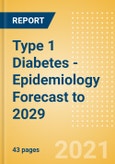Type 1 Diabetes (T1D), formerly referred to as insulin-dependent diabetes, is a type of diabetes that predominantly develops in children or young adults before the age of 40 years. The condition, therefore, was also referred to as juvenile diabetes. T1D accounts for about 5-10% of all diabetes cases and occurs as a result of the autoimmune destruction of pancreatic beta cells, which are responsible for producing insulin, a hormone that regulates blood sugar. If the condition is left untreated, blood sugar levels accumulate. In addition to the pancreas, high levels of blood sugar can damage other major organs such as the heart, blood vessels, nerves, eyes, and kidneys. Such damage can be life threatening; thus, T1D has an immense impact on the physical, psychological, and social well-being of patients. Furthermore, research suggests that the incidence of T1D is increasing globally, which may lead to an increased burden on healthcare resources (Holt, 2004; World Health Organization, 2013; Mayo Clinic, 2020).
In the 8MM, the diagnosed prevalent cases of T1D will increase from 3,329,294 cases in 2019 to 3,921,695 cases in 2029, at an Annual Growth Rate (AGR) of 1.78% per year. Among the 8MM, the US had the highest number of diagnosed prevalent cases of T1D in 2019 and 2029, at 1,719,922 cases and 1,880,013 cases, respectively. Canada had the lowest number of prevalent cases of T1D in 2019 and 2029, at 146,616 cases and 202,325 cases, respectively. Epidemiologists attribute the increase in the diagnosed prevalent cases of T1D in the 8MM to population changes as well as an increased trend in prevalence. However, further research is necessary to clearly understand the epidemiological factors responsible for the growth in the prevalent cases of T1D (Onkamo et al., 1999).
Scope
Reasons to Buy
The T1D Epidemiology series will allow you to -
In the 8MM, the diagnosed prevalent cases of T1D will increase from 3,329,294 cases in 2019 to 3,921,695 cases in 2029, at an Annual Growth Rate (AGR) of 1.78% per year. Among the 8MM, the US had the highest number of diagnosed prevalent cases of T1D in 2019 and 2029, at 1,719,922 cases and 1,880,013 cases, respectively. Canada had the lowest number of prevalent cases of T1D in 2019 and 2029, at 146,616 cases and 202,325 cases, respectively. Epidemiologists attribute the increase in the diagnosed prevalent cases of T1D in the 8MM to population changes as well as an increased trend in prevalence. However, further research is necessary to clearly understand the epidemiological factors responsible for the growth in the prevalent cases of T1D (Onkamo et al., 1999).
Scope
- Type 1 Diabetes (T1D) Epidemiology Report provides an overview of the risk factors, comorbidities, and the global and historical trends for T1D in the eight major markets (8MM: US, France, Germany, Italy, Spain, UK, Japan, and Canada). Additionally, the report includes a 10-year epidemiological forecast for the diagnosed prevalent cases of T1D segmented by age (ages under 20 years, 20-29 years, 30-44 years, 45-59 years, 60-74 years, and 75 years and older), sex, body mass index (BMI), brittle (difficult-to-control) diabetes, experienced a diabetic ketoacidosis event, experienced hypoglycemia events, eligible for pancreas and/or islet transplantation, and require/will undergo a kidney transplant or have already received a kidney transplant.
- The report also includes total prevalent cases of T1D for all ages and both sexes. To forecast the diagnosed prevalent cases of T1D in the 8MM, epidemiologists selected nationally representative population-based studies that provided data for the diagnosed prevalence of T1D in the 8MM.
- The T1D epidemiology report is written and developed by Masters- and PhD-level epidemiologists.
- The Epidemiology Report is in-depth, high quality, transparent and market-driven, providing expert analysis of disease trends in the 8MM.
Reasons to Buy
The T1D Epidemiology series will allow you to -
- Develop business strategies by understanding the trends shaping and driving the global T1D market.
- Quantify patient populations in the global T1D market to improve product design, pricing, and launch plans.
- Organize sales and marketing efforts by identifying the age groups that present the best opportunities for T1D therapeutics in each of the markets covered.
- Understand magnitude of T1D by BMI, brittle diabetes, diabetic ketoacidosis event, and hypoglycemia events.
Table of Contents
1 Table of Contents
2 T1D: Executive Summary
3 Epidemiology
4 Appendix
List of Tables
List of Figures
Samples

LOADING...








